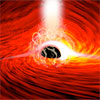| Jul 29, 2021 |
|
|
|
(Nanowerk News) Light cannot escape from a black hole, but for the first time ever, researchers have observed light from behind a black hole — a scenario that was predicted by Einstein’s theory of General Relativity but never confirmed, until now. In a paper published in Nature (“Light bending and X-ray echoes from behind a supermassive black hole”), a team including a Penn State scientist, report recordings of X-ray emissions from the far side of a black hole.
|
 |
| Illustration of a bright flare of X-ray emission and its echoes produced as gas falls into a supermassive black hole and reflects off of the gas falling into the black hole. Researchers have reported the first recording of these X-ray echoes consistent with X-rays reflected from behind the black hole. (Image: Dan Wilkins)
|
|
Watching X-rays flung out into the universe by the supermassive black hole at the center of a galaxy 800 million light-years away, the researchers noticed an intriguing pattern. They observed a series of bright flares of X-rays — exciting, but not unprecedented — and then, the telescopes recorded something unexpected: additional flashes of X-rays that were smaller, later, and of different “colors” than the bright flares.
|
|
“I have been studying the X-ray properties of this remarkable active galaxy since the mid-1990s,” said W. Niel Brandt, Verne M. Willaman Professor of Astronomy & Astrophysics and professor of physics at Penn State and a member of the research team. “Back then, with much more limited X-ray data, my team established that it showed remarkable X-ray properties, including characteristic strong X-ray variability. This strong variability turned out to be important for deriving this unprecedented result.”
|
|
According to theory, the luminous echoes observed were consistent with X-rays reflected from behind the black hole — but even a basic understanding of black holes tells us that is a strange place for light to come from.
|
|
“Any light that goes into that black hole doesn’t come out, so we shouldn’t be able to see anything that’s behind the black hole,” said Stanford University astrophysicist Dan Wilkins, the first author of the new paper who is a research scientist at the Kavli Institute for Particle Astrophysics and Cosmology at Stanford and SLAC National Accelerator Laboratory. “The reason we can see that is because that black hole is warping space, bending light and twisting magnetic fields around itself.”
|
|
The original motivation behind this research was to learn more about a mysterious feature of certain black holes, called a corona. Material falling into a supermassive black hole powers the brightest continuous sources of light in the universe, and as it does so, forms a corona around the black hole. This light — which is X-ray light — can be analyzed to map and characterize a black hole.
|
|
The leading theory for what a corona is starts with gas sliding into the black hole where it superheats to millions of degrees. At that temperature, electrons separate from atoms, creating a magnetized plasma. Caught up in the powerful spin of the black hole, the magnetic field arcs so high above the black hole, and twirls about itself so much, that it eventually breaks altogether — a situation so reminiscent of what happens around our own Sun that it borrowed the name “corona.”
|
|
“This magnetic field getting tied up and then snapping close to the black hole heats everything around it and produces these high-energy electrons that then go on to produce the X-rays,” said Wilkins.
|
 |
| Astronomers observed bright flares of X-ray emission, produced as gas falls into a supermassive black hole. The flares echo off of the gas falling into the black hole, and as the flares were subsiding, short flashes of X-rays were seen corresponding to the reflection of the flares from the far side of the disk, bent around the black hole by its strong gravitational field. (Image: ESA/S. Poletti) (click on image to enlarge)
|
|
For this project, the researchers trained two space-based X-ray observatories, NASA’s NuSTAR and the European Space Agency’s XMM-Newton, on the galaxy known as I Zwicky 1. The two bright flares that they observed are only the second example of flares that can be associated with a corona being launched away from a black hole.
|
|
The team processed the observations with a new technique, which takes advantage of the fact that the immense gravity around the black hole shifts the wavelength of light. By accounting for that shift and the time delay between the initial flash and when it bounces off the spinning disk of superhot gas encircling the black hole — known as an accretion disk — the researchers were able to translate the X-rays into a map of the environment just outside the event horizon of the black hole.
|
|
Upon a closer look to investigate the origin of the flares, the researchers saw the series of smaller flashes. These, they determined, are the same X-ray flares but reflected from the back of the disk — a first glimpse at the far side of a black hole.
|
|
“Fifty years ago, when astrophysicists starting speculating about how the magnetic field might behave close to a black hole, they had no idea that one day we might have the techniques to observe this directly and see Einstein’s general theory of relativity in action,” said Roger Blandford, a co-author of the paper, who is the Luke Blossom Professor in the School of Humanities and Sciences and Stanford and SLAC professor of physics and particle physics.
|
|
“It’s a delight to see the galaxy I Zwicky 1, my old friend from graduate school, still illuminating new aspects of cosmic black-hole feeding and growth,” said Brandt.
|




